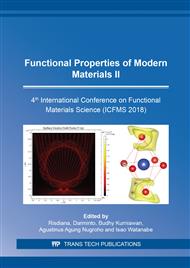[1]
M. A. Cooperstein, B. M. Bluestein, H. E. Canavan, Synthesis and optimization of fluorescent poly (N-isopropyl acrylamide)-coated surfaces by atom transfer radical polymerization for cell culture and detachment, Biointerphases 10 (2015) 019001.
DOI: 10.1116/1.4894530
Google Scholar
[2]
N. Roy, N. Saha, T. Kitano, P. Saha, Biodegradation of PVP–CMC hydrogel film: A useful food packaging material, Carbohydr. Polym. 89 (2012) 346–353.
DOI: 10.1016/j.carbpol.2012.03.008
Google Scholar
[3]
S. R. Muppalla, S. R. Kanatt, S. P. Chawla, A. Sharma, Carboxymethyl cellulose–polyvinyl alcohol films with clove oil for active packaging of ground chicken meat, Food Packag. Shelf Life 2 (2014) 51–58.
DOI: 10.1016/j.fpsl.2014.07.002
Google Scholar
[4]
A. Gregorova, N. Saha, T. Kitano, P. Saha, Hydrothermal effect and mechanical stress properties of carboxymethylcellulose based hydrogel food packaging, Carbohydr. Polym. 117 (2015) 559–568.
DOI: 10.1016/j.carbpol.2014.10.009
Google Scholar
[5]
R. M. Cornell, U. Schwertmann, Electronic, Electrical and Magnetic Properties and Colour, in The Iron Oxides, Wiley-VCH Verlag GmbH & Co. KGaA, (2004) 111–137.
Google Scholar
[6]
M. Ma, Y. Zhang, W. Yu, H. Shen, H. Zhang, N. Gu, Preparation and characterization of magnetite nanoparticles coated by amino silane, Colloids Surf. Physicochem. Eng. Asp. 212 (2003) 219–226.
DOI: 10.1016/s0927-7757(02)00305-9
Google Scholar
[7]
C. Hassan, N. Peppas, Structure and Applications of Poly(vinyl alcohol) Hydrogels Produced by Conventional Crosslinking or by Freezing/Thawing Methods, in Biopolymers · PVA Hydrogels, Anionic Polymerisation Nanocomposites, Springer Berlin Heidelberg, 153 (2000) 37–65.
DOI: 10.1007/3-540-46414-x_2
Google Scholar
[8]
J. Thomas, A. Lowman, M. Marcolongo, Novel associated hydrogels for nucleus pulposus replacement., J. Biomed. Mater. Res. A 67 (2003) 1329–1337.
DOI: 10.1002/jbm.a.10119
Google Scholar
[9]
N. A. Peppas, S. L. Wright, Solute Diffusion in Poly(vinyl alcohol)/Poly(acrylic acid) Interpenetrating Networks, Macromolecules 29 (1996) 8798–8804.
DOI: 10.1021/ma9613392
Google Scholar
[10]
A. Doyan, K. Khalilurrahman, S. Susilawati, Sintesis dan Uji FTIR Barium M-Hexaferrite dengan Doping Logam Mn, J. Pendidik. Fis. Dan Teknol. 1 (2017) 235–238.
DOI: 10.29303/jpft.v1i4.264
Google Scholar
[11]
O.R. R. S. F. Thermoplastic, E. N. B. R. NBR, Sifat fisika dan analisis gugus fungsi karet seal o-ring dari bahan termoplastik elastomer nitrile butadiene rubber (NBR) dan polyvinyl chloride (PVC), (2013).
DOI: 10.20543/mkkp.v29i1.215
Google Scholar
[12]
H. S. Mansur, R. L. Oréfice, A. A. P. Mansur, Characterization of poly(vinyl alcohol)/poly(ethylene glycol) hydrogels and PVA-derived hybrids by small-angle X-ray scattering and FTIR spectroscopy, Polymer 45 (2004) 7193–7202.
DOI: 10.1016/j.polymer.2004.08.036
Google Scholar
[13]
T. M. G. Ginanjar, S. Amanda, C. Syari, Model baru advanced packaging melalui mekanisme aktif oxygen scavenging dari chitosan untuk kemasan suplemen pangan kecerdasan berbasis asam lemak omega-3 minyak ikan (2014).
Google Scholar
[14]
Z. L. Liu, Y. J. Liu, K. L. Yao, Z. H. Ding, J. Tao, X. Wang, Synthesis and magnetic properties of Fe3O4 nanoparticles, J. Mater. Synth. Process. 10 (2002) 83–87.
Google Scholar
[15]
A. V. Ryzhkov, P. V. Melenev, M. Balasoiu, Y. L. Raikher, Structure organization and magnetic properties of microscale ferrogels: The effect of particle magnetic anisotropy, J. Chem. Phys. 145 (2016) 074905.
DOI: 10.1063/1.4961299
Google Scholar
[16]
E. G. R. Putra, B. S. Seong, E. Shin, A. Ikram, S. A. Ani, Darminto, Fractal Structures on Fe3O4 Ferrofluid: A Small-Angle Neutron Scattering Study, J. Phys. Conf. Ser. 247 (2010) 012028.
DOI: 10.1088/1742-6596/247/1/012028
Google Scholar
[17]
J. Teixeira, Small-angle scattering by fractal systems, J. Appl. Crystallogr. 21 (1988) 781–785.
DOI: 10.1107/s0021889888000263
Google Scholar
[18]
Sunaryono, A. Taufiq, E.G.R. Putra, A. Okazawa, I. Watanabe, N. Kojima, S. Rugmai, S. Soontaranon, M. Zainuri, Triwikantoro, S. Pratapa, Darminto, Small-Angle X-Ray Scattering Study on PVA/Fe3O4 Magnetic Hydrogels, Nano 11 (2016) 1650027.
DOI: 10.1142/s1793292016500272
Google Scholar
[19]
A. Priola, A. Di Gianni, R. Bongiovanni, S.G. Starodubtsev, S.S. Abramchuck, S.N. Polyakov, V.V. Volkov, E.V. Schtykova, K.A. Dembo, Effect of the swelling degree on the formation of magnetite nanoparticles in hydrogels, Eur. Polym. J. 46 (2010) 2105–2111.
DOI: 10.1016/j.eurpolymj.2010.09.008
Google Scholar
[20]
R. V. Ramanujan, L. L. Lao, The mechanical behavior of smart magnet–hydrogel composites, Smart Mater. Struct. 15 (2006) 952.
DOI: 10.1088/0964-1726/15/4/008
Google Scholar
[21]
M. Zrinyi, L. Barsi, A. Büki, Direct observation of discrete and reversible shape transition in magnetic field sensitive polymer gels, Print. On (2005) 1–6.].
Google Scholar
[22]
Sunaryono, A. Taufiq, Munaji, B. Indarto, Triwikantoro, M. Zainuri, Darminto, Magneto-elasticity in hydrogels containing Fe3O4 nanoparticles and their potential applications, (2013) 53–56.
DOI: 10.1063/1.4820992
Google Scholar
[23]
M. Czaun, L. Hevesi, M. Takafuji, H. Ihara, A novel approach to magneto-responsive polymeric gels assisted by iron nanoparticles as nano cross-linkers, Chem. Commun. (2008) 2124–2126.
DOI: 10.1039/b717721f
Google Scholar


